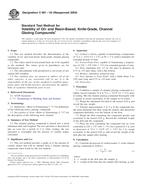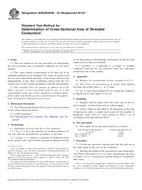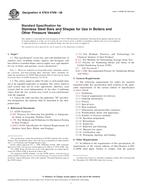1.1 This practice describes minimum data required to locate and identify a postmining land use for a surface coal mining and reclamation operation. Statutory language and definitions are found in Federal regulations 30 CFR 816/817.133 and 30 CFR 701.5.
1.1.1 These postmining land use designations reflect coal mining reclamation practices relative to the standards set forth in the Surface Mining Control and Reclamation Act of 1977 (SMCRA). Geospatial data associated with postmining land use shall be obtained from each regulatory authority (RA), which are authorized under SMCRA to regulate surface coal mining operations (SCMO) and reclamation activities within their borders. Each RA shall be the authoritative data source (ADS) for coal mining geospatial data.
1.2 This standard is one of several that have been approved or are in development related to SMCRA approved coal mining operations. Also under development is a terminology standard. Initial development of these standards is being done on an individual basis; however, they may be consolidated to reduce repetition of information between them.
1.3 This practice is limited to permitted coal mining operations after the passage of SMCRA.
1.4 SMCRA identifies land use categories for surface coal mining permits, such as cropland, pasture/hayland, grazing land, forest, residential, fish and wildlife habitat, developed water resources, public utilities, industrial/commercial, and recreation.
1.5 Postmining land uses for mountaintop removal and steep slope mining operations with approximate original contour (AOC) variances include the following:
1.5.1 A mountaintop removal AOC variance may only be granted if the applicant proposes to remove the entire coal seam or seams running through the upper fraction of the hill, ridge, or mountain creating a level plateau or gently rolling contour with no highwalls remaining, and capable of supporting the following postmining land uses.
1.5.2 The proposed postmining land use for a mountaintop removal operation with an AOC variance is limited to industrial, commercial, agricultural, residential, or public facility use.
1.5.3 The proposed use constitutes an equal or better economic or public use compared with the pre-mining use.
1.5.4 The proposed use will be compatible with adjacent land uses and existing state and local land use plans.
1.5.5 County commissions and other state and federal agencies were provided an opportunity to review and comment on the proposed postmining land use.
1.5.6 The application contains a specific plan and assurances that the proposed postmining land use will be:
1.5.6.1 Compatible with adjacent land uses; practicable with respect to financing and completing the proposed use; supported by commitments from public agencies where appropriate;
1.5.6.2 Planned pursuant to a schedule attached to the reclamation plan so as to integrate the mining operation and reclamation with the postmining land use;
1.5.6.3 Designed by a registered professional engineer to assure the stability, drainage, and configuration necessary for the intended use of the site.
1.6 Units – The values stated in either SI units or inch-pound units are to be regarded separately as standard. The values stated in each system may not be exact equivalents; therefore, each system shall be used independently of the other. Combining values from the two systems may result in non-conformance with the standard.
1.7 This practice offers a set of instructions for performing one or more specific operations. This document cannot replace education or experience and should be used in conjunction with professional judgment. Not all aspects of this practice may be applicable in all circumstances. This ASTM standard is not intended to represent or replace the standard of care by which the adequacy of a given professional service must be judged, nor should this document be applied without consideration of a project's many unique aspects. The word “Standard“ in the title of this document means only that the document has been approved through the ASTM consensus process.
1.8 This standard does not purport to address all of the safety concerns, if any, associated with its use. It is the responsibility of the user of this standard to establish appropriate safety and health practices and determine the applicability of regulatory limitations prior to use.
Product Details
- Published:
- 05/15/2010
- Number of Pages:
- 6
- File Size:
- 1 file , 84 KB


